Taxation Law: Residency, Income Sources, and Dividend Taxation
VerifiedAdded on 2023/03/17
|8
|1540
|20
Report
AI Summary
This report delves into Australian taxation law, examining the critical aspects of residency and income source determination. It begins by defining Australian residency based on the ITAA 1997, outlining the common law, domicile, 183-day, and superannuation fund tests, and applying these tests to a case study involving an individual with German citizenship working in China. The analysis determines the individual's residency status and the implications for taxation. The report then addresses the taxation of income sources, including employment income, referencing relevant case law such as FCT v French (1957), and the application of section 23AG of the ITAA 1936 regarding the exemption of foreign-sourced service income. The report further explores the taxation of dividends for non-residents, according to ATO guidelines, differentiating between franked and unfranked dividends, and the implications for withholding tax and franking tax offsets. The analysis is supported by ATO guidelines and case law, providing a comprehensive overview of the tax implications for both residents and non-residents. Finally, the report concludes with a discussion on the taxation of rental income for non-residents.
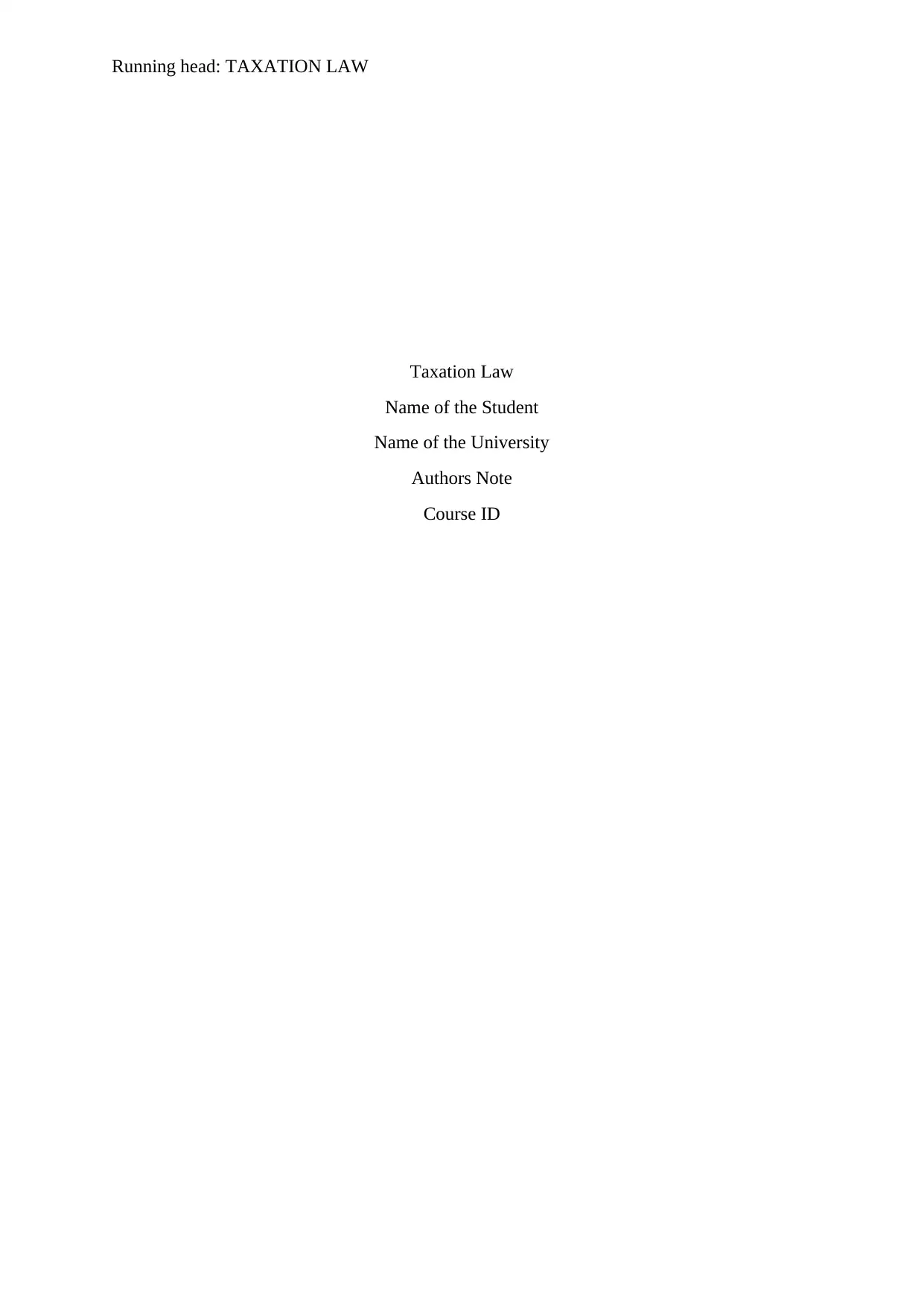
Running head: TAXATION LAW
Taxation Law
Name of the Student
Name of the University
Authors Note
Course ID
Taxation Law
Name of the Student
Name of the University
Authors Note
Course ID
Paraphrase This Document
Need a fresh take? Get an instant paraphrase of this document with our AI Paraphraser
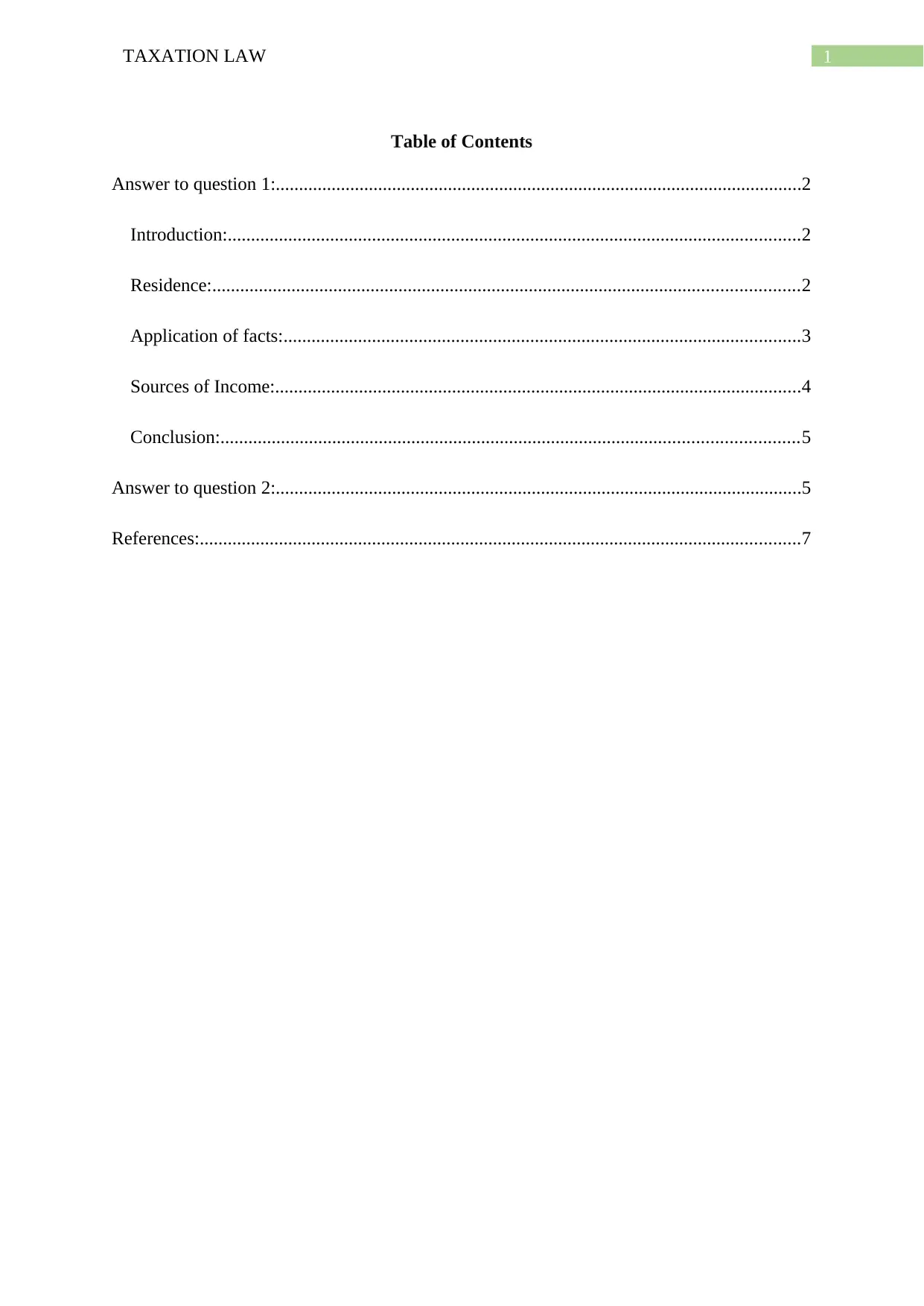
1TAXATION LAW
Table of Contents
Answer to question 1:.................................................................................................................2
Introduction:...........................................................................................................................2
Residence:..............................................................................................................................2
Application of facts:...............................................................................................................3
Sources of Income:.................................................................................................................4
Conclusion:............................................................................................................................5
Answer to question 2:.................................................................................................................5
References:.................................................................................................................................7
Table of Contents
Answer to question 1:.................................................................................................................2
Introduction:...........................................................................................................................2
Residence:..............................................................................................................................2
Application of facts:...............................................................................................................3
Sources of Income:.................................................................................................................4
Conclusion:............................................................................................................................5
Answer to question 2:.................................................................................................................5
References:.................................................................................................................................7
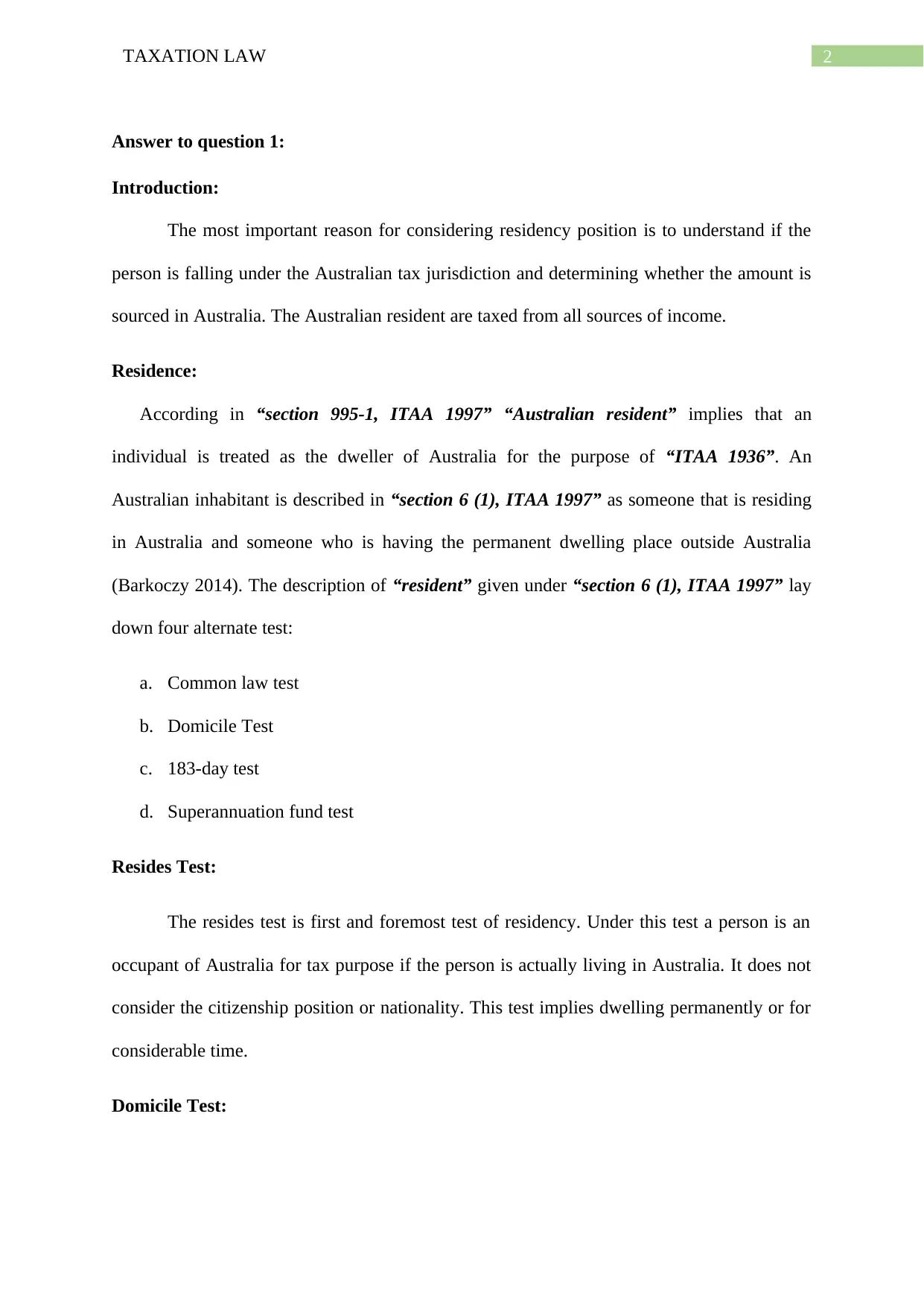
2TAXATION LAW
Answer to question 1:
Introduction:
The most important reason for considering residency position is to understand if the
person is falling under the Australian tax jurisdiction and determining whether the amount is
sourced in Australia. The Australian resident are taxed from all sources of income.
Residence:
According in “section 995-1, ITAA 1997” “Australian resident” implies that an
individual is treated as the dweller of Australia for the purpose of “ITAA 1936”. An
Australian inhabitant is described in “section 6 (1), ITAA 1997” as someone that is residing
in Australia and someone who is having the permanent dwelling place outside Australia
(Barkoczy 2014). The description of “resident” given under “section 6 (1), ITAA 1997” lay
down four alternate test:
a. Common law test
b. Domicile Test
c. 183-day test
d. Superannuation fund test
Resides Test:
The resides test is first and foremost test of residency. Under this test a person is an
occupant of Australia for tax purpose if the person is actually living in Australia. It does not
consider the citizenship position or nationality. This test implies dwelling permanently or for
considerable time.
Domicile Test:
Answer to question 1:
Introduction:
The most important reason for considering residency position is to understand if the
person is falling under the Australian tax jurisdiction and determining whether the amount is
sourced in Australia. The Australian resident are taxed from all sources of income.
Residence:
According in “section 995-1, ITAA 1997” “Australian resident” implies that an
individual is treated as the dweller of Australia for the purpose of “ITAA 1936”. An
Australian inhabitant is described in “section 6 (1), ITAA 1997” as someone that is residing
in Australia and someone who is having the permanent dwelling place outside Australia
(Barkoczy 2014). The description of “resident” given under “section 6 (1), ITAA 1997” lay
down four alternate test:
a. Common law test
b. Domicile Test
c. 183-day test
d. Superannuation fund test
Resides Test:
The resides test is first and foremost test of residency. Under this test a person is an
occupant of Australia for tax purpose if the person is actually living in Australia. It does not
consider the citizenship position or nationality. This test implies dwelling permanently or for
considerable time.
Domicile Test:
⊘ This is a preview!⊘
Do you want full access?
Subscribe today to unlock all pages.

Trusted by 1+ million students worldwide
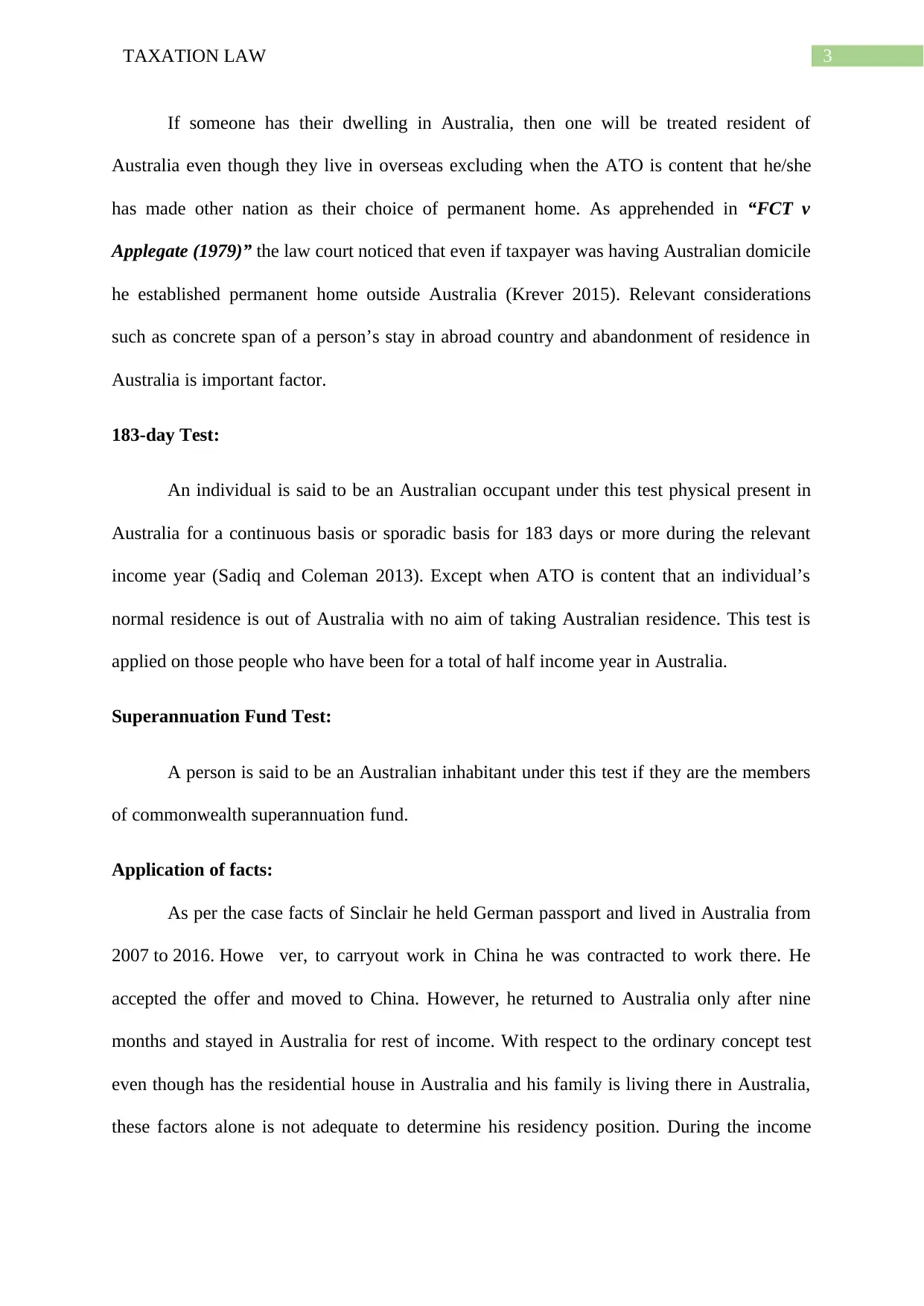
3TAXATION LAW
If someone has their dwelling in Australia, then one will be treated resident of
Australia even though they live in overseas excluding when the ATO is content that he/she
has made other nation as their choice of permanent home. As apprehended in “FCT v
Applegate (1979)” the law court noticed that even if taxpayer was having Australian domicile
he established permanent home outside Australia (Krever 2015). Relevant considerations
such as concrete span of a person’s stay in abroad country and abandonment of residence in
Australia is important factor.
183-day Test:
An individual is said to be an Australian occupant under this test physical present in
Australia for a continuous basis or sporadic basis for 183 days or more during the relevant
income year (Sadiq and Coleman 2013). Except when ATO is content that an individual’s
normal residence is out of Australia with no aim of taking Australian residence. This test is
applied on those people who have been for a total of half income year in Australia.
Superannuation Fund Test:
A person is said to be an Australian inhabitant under this test if they are the members
of commonwealth superannuation fund.
Application of facts:
As per the case facts of Sinclair he held German passport and lived in Australia from
2007 to 2016. Howe ver, to carryout work in China he was contracted to work there. He
accepted the offer and moved to China. However, he returned to Australia only after nine
months and stayed in Australia for rest of income. With respect to the ordinary concept test
even though has the residential house in Australia and his family is living there in Australia,
these factors alone is not adequate to determine his residency position. During the income
If someone has their dwelling in Australia, then one will be treated resident of
Australia even though they live in overseas excluding when the ATO is content that he/she
has made other nation as their choice of permanent home. As apprehended in “FCT v
Applegate (1979)” the law court noticed that even if taxpayer was having Australian domicile
he established permanent home outside Australia (Krever 2015). Relevant considerations
such as concrete span of a person’s stay in abroad country and abandonment of residence in
Australia is important factor.
183-day Test:
An individual is said to be an Australian occupant under this test physical present in
Australia for a continuous basis or sporadic basis for 183 days or more during the relevant
income year (Sadiq and Coleman 2013). Except when ATO is content that an individual’s
normal residence is out of Australia with no aim of taking Australian residence. This test is
applied on those people who have been for a total of half income year in Australia.
Superannuation Fund Test:
A person is said to be an Australian inhabitant under this test if they are the members
of commonwealth superannuation fund.
Application of facts:
As per the case facts of Sinclair he held German passport and lived in Australia from
2007 to 2016. Howe ver, to carryout work in China he was contracted to work there. He
accepted the offer and moved to China. However, he returned to Australia only after nine
months and stayed in Australia for rest of income. With respect to the ordinary concept test
even though has the residential house in Australia and his family is living there in Australia,
these factors alone is not adequate to determine his residency position. During the income
Paraphrase This Document
Need a fresh take? Get an instant paraphrase of this document with our AI Paraphraser
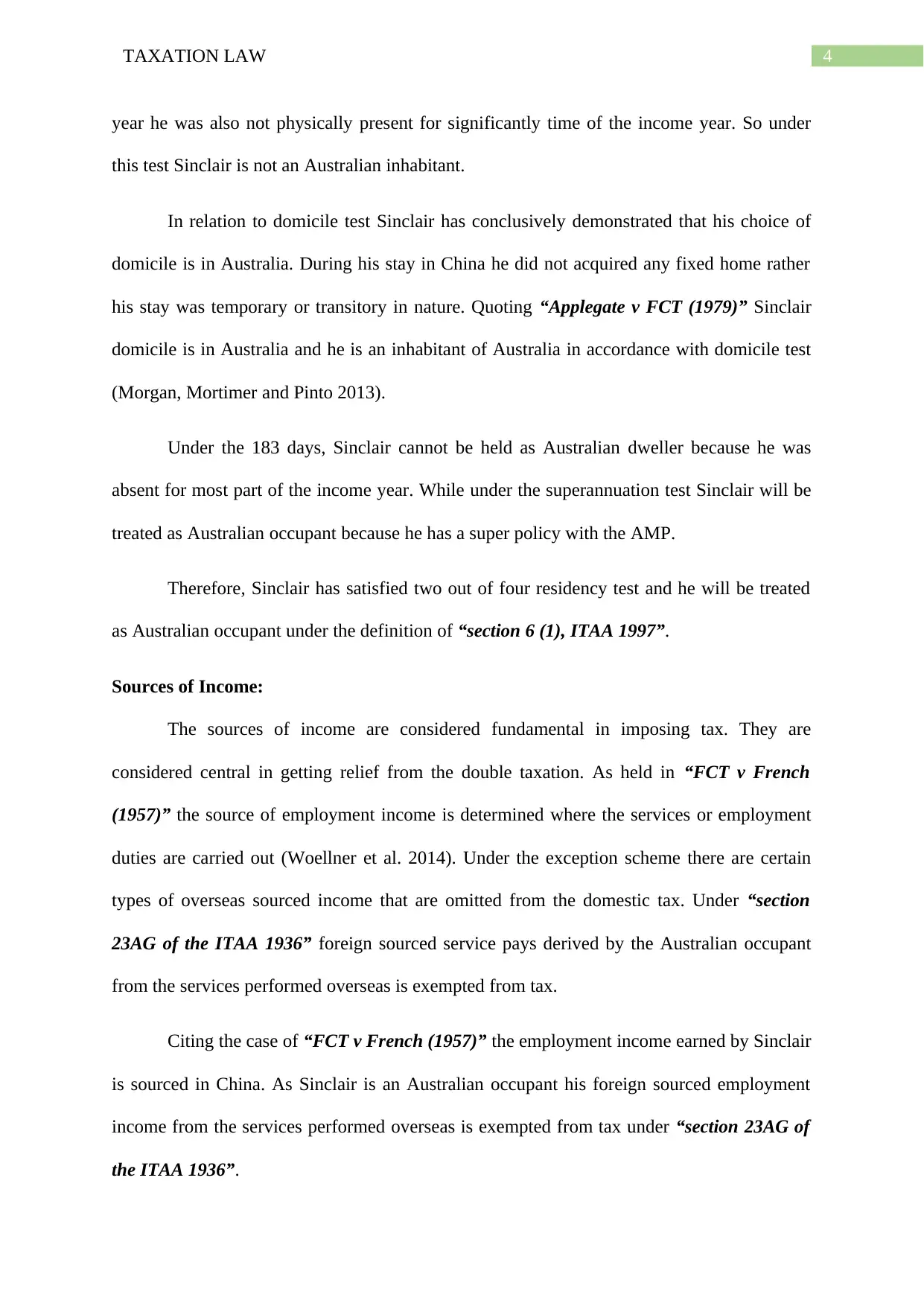
4TAXATION LAW
year he was also not physically present for significantly time of the income year. So under
this test Sinclair is not an Australian inhabitant.
In relation to domicile test Sinclair has conclusively demonstrated that his choice of
domicile is in Australia. During his stay in China he did not acquired any fixed home rather
his stay was temporary or transitory in nature. Quoting “Applegate v FCT (1979)” Sinclair
domicile is in Australia and he is an inhabitant of Australia in accordance with domicile test
(Morgan, Mortimer and Pinto 2013).
Under the 183 days, Sinclair cannot be held as Australian dweller because he was
absent for most part of the income year. While under the superannuation test Sinclair will be
treated as Australian occupant because he has a super policy with the AMP.
Therefore, Sinclair has satisfied two out of four residency test and he will be treated
as Australian occupant under the definition of “section 6 (1), ITAA 1997”.
Sources of Income:
The sources of income are considered fundamental in imposing tax. They are
considered central in getting relief from the double taxation. As held in “FCT v French
(1957)” the source of employment income is determined where the services or employment
duties are carried out (Woellner et al. 2014). Under the exception scheme there are certain
types of overseas sourced income that are omitted from the domestic tax. Under “section
23AG of the ITAA 1936” foreign sourced service pays derived by the Australian occupant
from the services performed overseas is exempted from tax.
Citing the case of “FCT v French (1957)” the employment income earned by Sinclair
is sourced in China. As Sinclair is an Australian occupant his foreign sourced employment
income from the services performed overseas is exempted from tax under “section 23AG of
the ITAA 1936”.
year he was also not physically present for significantly time of the income year. So under
this test Sinclair is not an Australian inhabitant.
In relation to domicile test Sinclair has conclusively demonstrated that his choice of
domicile is in Australia. During his stay in China he did not acquired any fixed home rather
his stay was temporary or transitory in nature. Quoting “Applegate v FCT (1979)” Sinclair
domicile is in Australia and he is an inhabitant of Australia in accordance with domicile test
(Morgan, Mortimer and Pinto 2013).
Under the 183 days, Sinclair cannot be held as Australian dweller because he was
absent for most part of the income year. While under the superannuation test Sinclair will be
treated as Australian occupant because he has a super policy with the AMP.
Therefore, Sinclair has satisfied two out of four residency test and he will be treated
as Australian occupant under the definition of “section 6 (1), ITAA 1997”.
Sources of Income:
The sources of income are considered fundamental in imposing tax. They are
considered central in getting relief from the double taxation. As held in “FCT v French
(1957)” the source of employment income is determined where the services or employment
duties are carried out (Woellner et al. 2014). Under the exception scheme there are certain
types of overseas sourced income that are omitted from the domestic tax. Under “section
23AG of the ITAA 1936” foreign sourced service pays derived by the Australian occupant
from the services performed overseas is exempted from tax.
Citing the case of “FCT v French (1957)” the employment income earned by Sinclair
is sourced in China. As Sinclair is an Australian occupant his foreign sourced employment
income from the services performed overseas is exempted from tax under “section 23AG of
the ITAA 1936”.
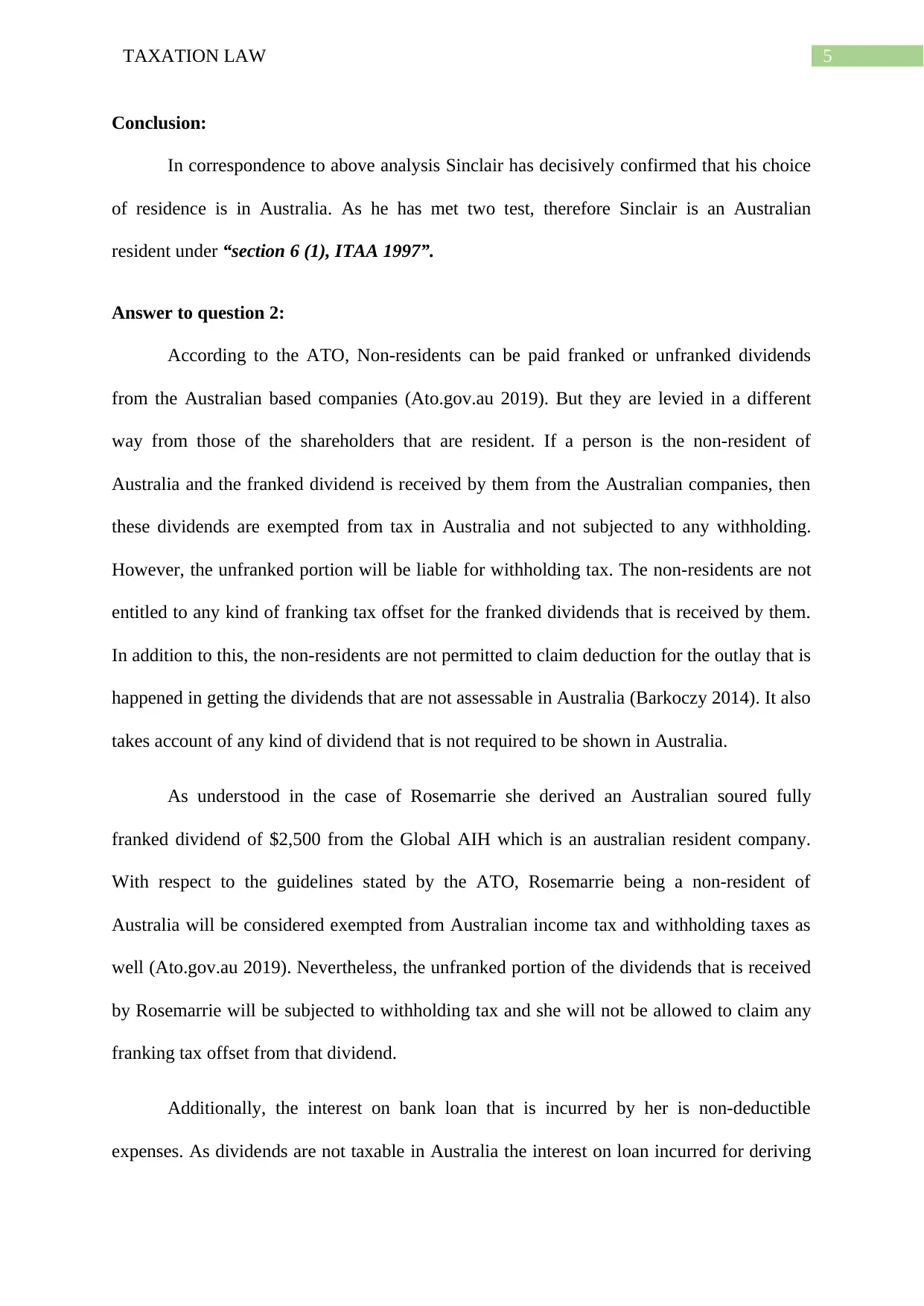
5TAXATION LAW
Conclusion:
In correspondence to above analysis Sinclair has decisively confirmed that his choice
of residence is in Australia. As he has met two test, therefore Sinclair is an Australian
resident under “section 6 (1), ITAA 1997”.
Answer to question 2:
According to the ATO, Non-residents can be paid franked or unfranked dividends
from the Australian based companies (Ato.gov.au 2019). But they are levied in a different
way from those of the shareholders that are resident. If a person is the non-resident of
Australia and the franked dividend is received by them from the Australian companies, then
these dividends are exempted from tax in Australia and not subjected to any withholding.
However, the unfranked portion will be liable for withholding tax. The non-residents are not
entitled to any kind of franking tax offset for the franked dividends that is received by them.
In addition to this, the non-residents are not permitted to claim deduction for the outlay that is
happened in getting the dividends that are not assessable in Australia (Barkoczy 2014). It also
takes account of any kind of dividend that is not required to be shown in Australia.
As understood in the case of Rosemarrie she derived an Australian soured fully
franked dividend of $2,500 from the Global AIH which is an australian resident company.
With respect to the guidelines stated by the ATO, Rosemarrie being a non-resident of
Australia will be considered exempted from Australian income tax and withholding taxes as
well (Ato.gov.au 2019). Nevertheless, the unfranked portion of the dividends that is received
by Rosemarrie will be subjected to withholding tax and she will not be allowed to claim any
franking tax offset from that dividend.
Additionally, the interest on bank loan that is incurred by her is non-deductible
expenses. As dividends are not taxable in Australia the interest on loan incurred for deriving
Conclusion:
In correspondence to above analysis Sinclair has decisively confirmed that his choice
of residence is in Australia. As he has met two test, therefore Sinclair is an Australian
resident under “section 6 (1), ITAA 1997”.
Answer to question 2:
According to the ATO, Non-residents can be paid franked or unfranked dividends
from the Australian based companies (Ato.gov.au 2019). But they are levied in a different
way from those of the shareholders that are resident. If a person is the non-resident of
Australia and the franked dividend is received by them from the Australian companies, then
these dividends are exempted from tax in Australia and not subjected to any withholding.
However, the unfranked portion will be liable for withholding tax. The non-residents are not
entitled to any kind of franking tax offset for the franked dividends that is received by them.
In addition to this, the non-residents are not permitted to claim deduction for the outlay that is
happened in getting the dividends that are not assessable in Australia (Barkoczy 2014). It also
takes account of any kind of dividend that is not required to be shown in Australia.
As understood in the case of Rosemarrie she derived an Australian soured fully
franked dividend of $2,500 from the Global AIH which is an australian resident company.
With respect to the guidelines stated by the ATO, Rosemarrie being a non-resident of
Australia will be considered exempted from Australian income tax and withholding taxes as
well (Ato.gov.au 2019). Nevertheless, the unfranked portion of the dividends that is received
by Rosemarrie will be subjected to withholding tax and she will not be allowed to claim any
franking tax offset from that dividend.
Additionally, the interest on bank loan that is incurred by her is non-deductible
expenses. As dividends are not taxable in Australia the interest on loan incurred for deriving
⊘ This is a preview!⊘
Do you want full access?
Subscribe today to unlock all pages.

Trusted by 1+ million students worldwide
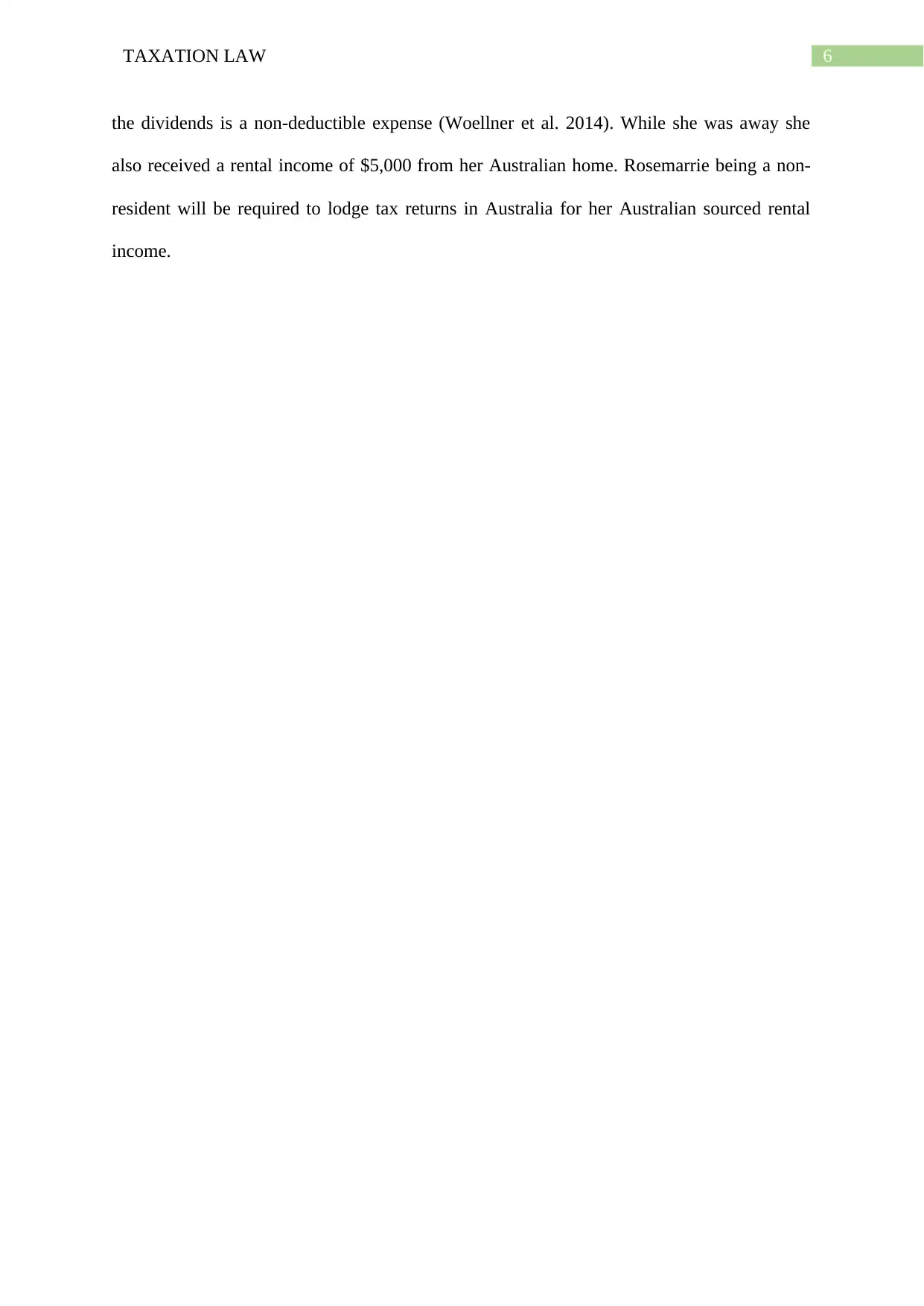
6TAXATION LAW
the dividends is a non-deductible expense (Woellner et al. 2014). While she was away she
also received a rental income of $5,000 from her Australian home. Rosemarrie being a non-
resident will be required to lodge tax returns in Australia for her Australian sourced rental
income.
the dividends is a non-deductible expense (Woellner et al. 2014). While she was away she
also received a rental income of $5,000 from her Australian home. Rosemarrie being a non-
resident will be required to lodge tax returns in Australia for her Australian sourced rental
income.
Paraphrase This Document
Need a fresh take? Get an instant paraphrase of this document with our AI Paraphraser
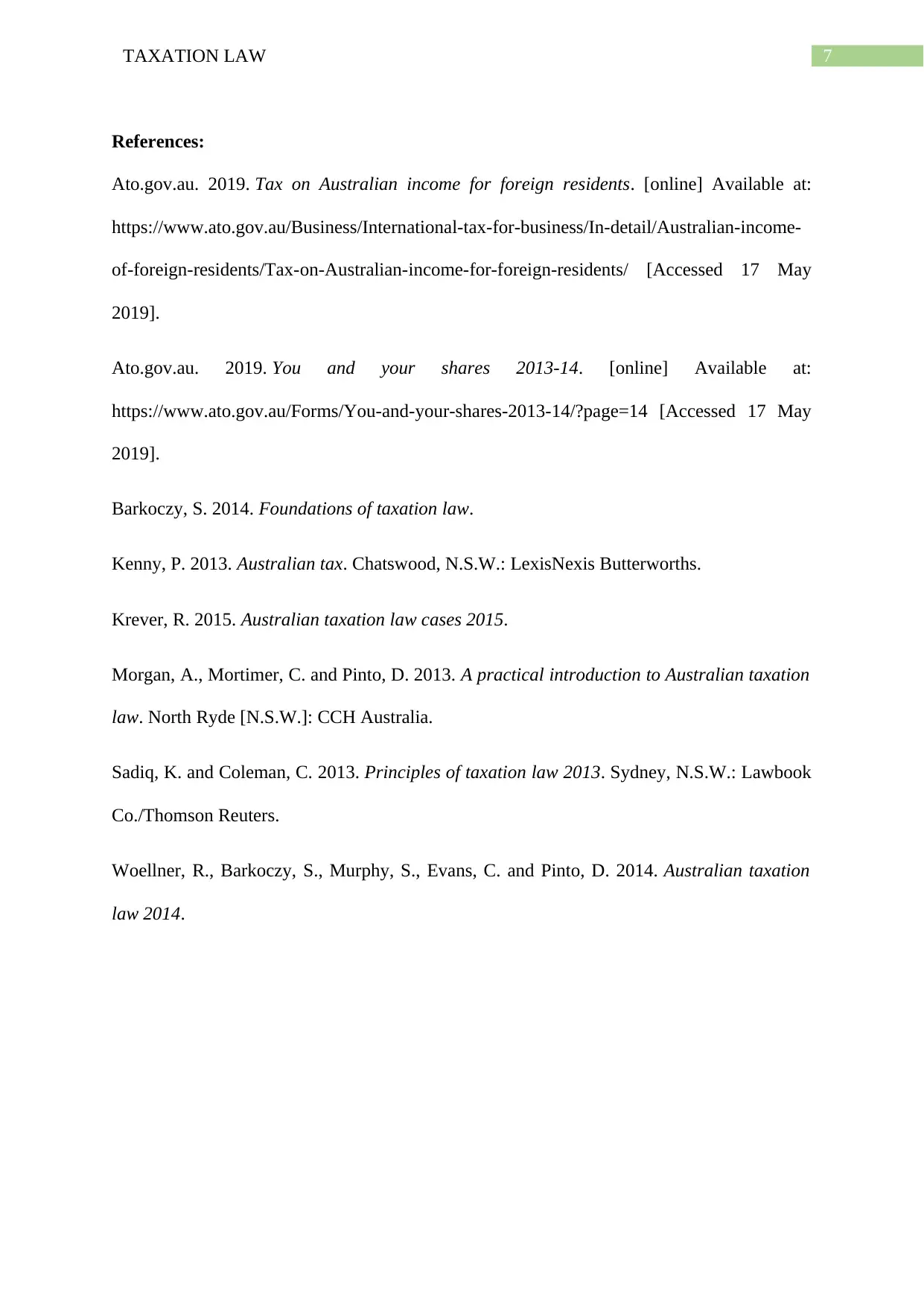
7TAXATION LAW
References:
Ato.gov.au. 2019. Tax on Australian income for foreign residents. [online] Available at:
https://www.ato.gov.au/Business/International-tax-for-business/In-detail/Australian-income-
of-foreign-residents/Tax-on-Australian-income-for-foreign-residents/ [Accessed 17 May
2019].
Ato.gov.au. 2019. You and your shares 2013-14. [online] Available at:
https://www.ato.gov.au/Forms/You-and-your-shares-2013-14/?page=14 [Accessed 17 May
2019].
Barkoczy, S. 2014. Foundations of taxation law.
Kenny, P. 2013. Australian tax. Chatswood, N.S.W.: LexisNexis Butterworths.
Krever, R. 2015. Australian taxation law cases 2015.
Morgan, A., Mortimer, C. and Pinto, D. 2013. A practical introduction to Australian taxation
law. North Ryde [N.S.W.]: CCH Australia.
Sadiq, K. and Coleman, C. 2013. Principles of taxation law 2013. Sydney, N.S.W.: Lawbook
Co./Thomson Reuters.
Woellner, R., Barkoczy, S., Murphy, S., Evans, C. and Pinto, D. 2014. Australian taxation
law 2014.
References:
Ato.gov.au. 2019. Tax on Australian income for foreign residents. [online] Available at:
https://www.ato.gov.au/Business/International-tax-for-business/In-detail/Australian-income-
of-foreign-residents/Tax-on-Australian-income-for-foreign-residents/ [Accessed 17 May
2019].
Ato.gov.au. 2019. You and your shares 2013-14. [online] Available at:
https://www.ato.gov.au/Forms/You-and-your-shares-2013-14/?page=14 [Accessed 17 May
2019].
Barkoczy, S. 2014. Foundations of taxation law.
Kenny, P. 2013. Australian tax. Chatswood, N.S.W.: LexisNexis Butterworths.
Krever, R. 2015. Australian taxation law cases 2015.
Morgan, A., Mortimer, C. and Pinto, D. 2013. A practical introduction to Australian taxation
law. North Ryde [N.S.W.]: CCH Australia.
Sadiq, K. and Coleman, C. 2013. Principles of taxation law 2013. Sydney, N.S.W.: Lawbook
Co./Thomson Reuters.
Woellner, R., Barkoczy, S., Murphy, S., Evans, C. and Pinto, D. 2014. Australian taxation
law 2014.
1 out of 8
Related Documents
Your All-in-One AI-Powered Toolkit for Academic Success.
+13062052269
info@desklib.com
Available 24*7 on WhatsApp / Email
![[object Object]](/_next/static/media/star-bottom.7253800d.svg)
Unlock your academic potential
Copyright © 2020–2025 A2Z Services. All Rights Reserved. Developed and managed by ZUCOL.





